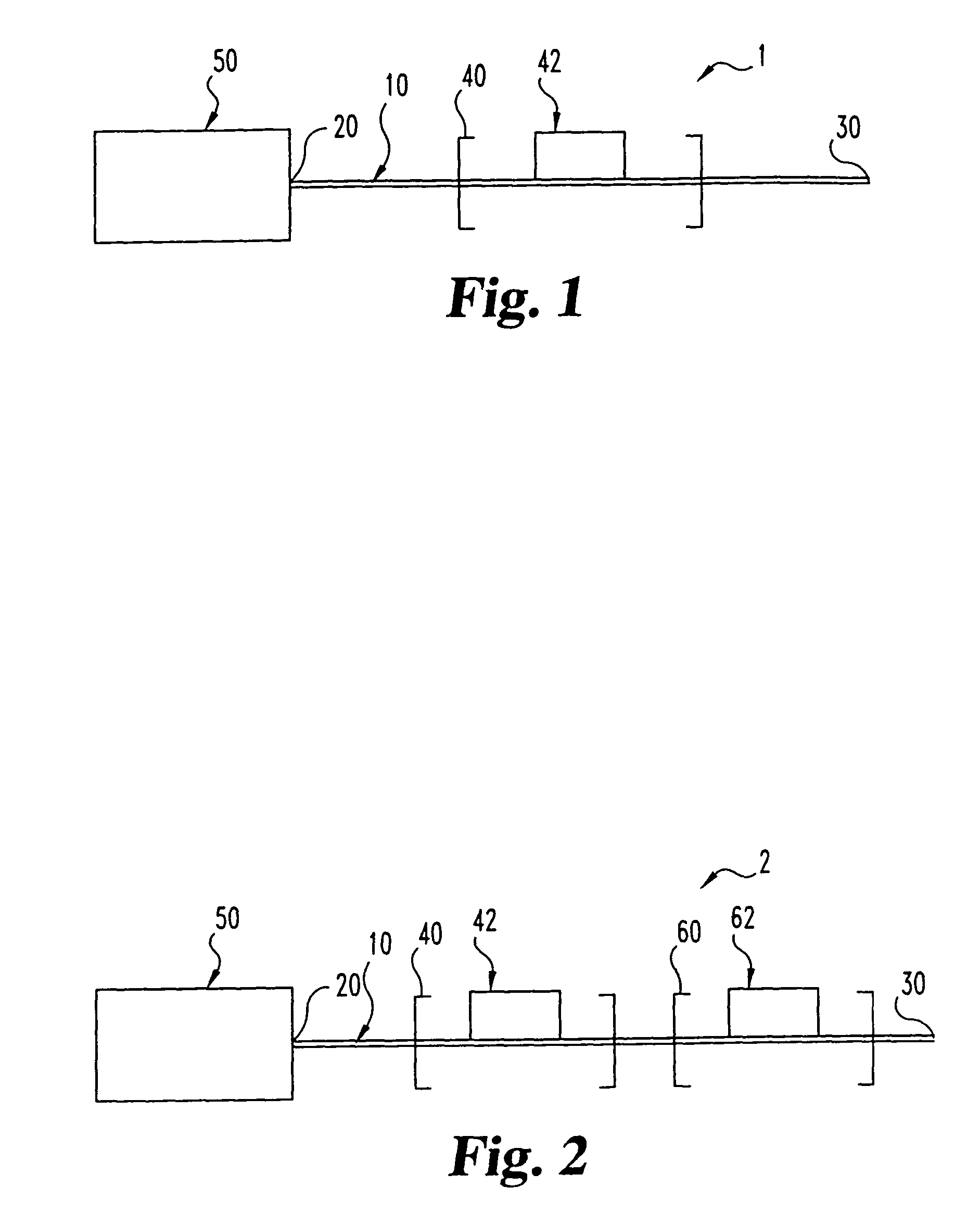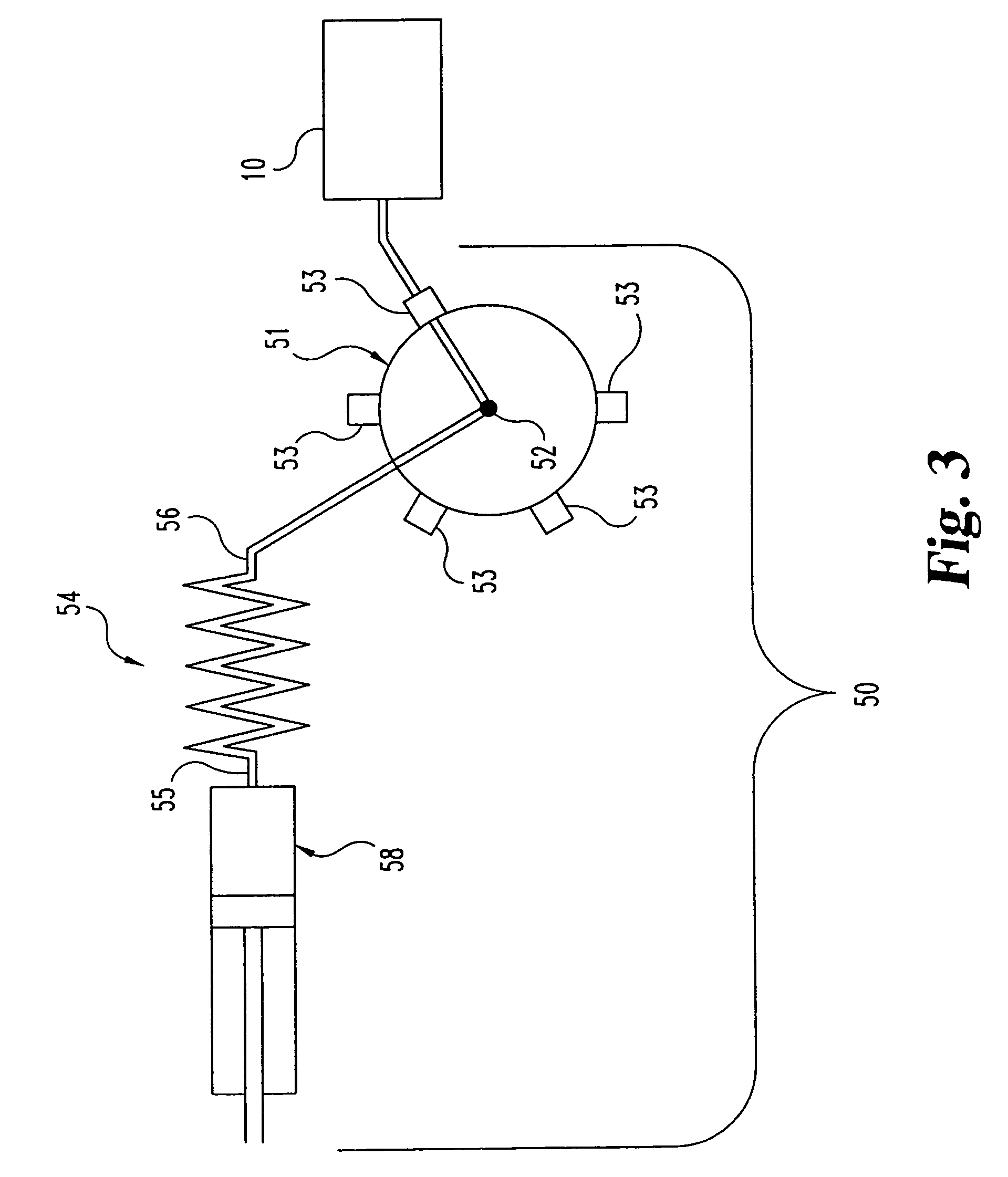Flow-controlled magnetic particle manipulation
a magnetic particle and flow control technology, applied in the field of flow-controlled magnetic particle manipulation, can solve the problems of limited lifetime of a chemically selective surface, inability to keep a biosensor surface immersed in aqueous solution continuously, and difficulty in using whole cells in the sensor system, so as to improve mixing and thus molecular capture efficiency
- Summary
- Abstract
- Description
- Claims
- Application Information
AI Technical Summary
Benefits of technology
Problems solved by technology
Method used
Image
Examples
example one
Sequential Injection Analysis of TNT in Water Using an Enzyme-Linked Immunosorbent Assay
[0087]An experiment was conducted to demonstrate capture and resuspension of magnetic particles in an inventive system as follows:
[0088]Chemicals: TNT RaPID Assay™ kits provided the ELISA reagents (Strategic Diagnostics, Newark, Del.). The reagents used were a TNT-horseradish peroxidase (TNT-HRP) conjugate, a color development solution (3,3′5,5′-tetramethylbenzidine and H2O2), and the suspension of irregular 0.5 μm diameter magnetic particles with immobilized anti-TNT antibody. The color development reagent solution contained the chromogenic substrate 3,3′,5,5′-tetramethylbenzidine (TMB) and H2O2. Exact formulations are proprietary, but optimized reagent formulations have been published for similar atrazine ELISAs using HRP-atrazine conjugate and TMB. C. S. Hottenstein, F. M. Rubio, D. P. Herzog, J. R. Fleeker and T. S. Lawruk, “Determination of trace atrazine levels in water by a sensitive magne...
example two
Cleaning of Apparatus Between Assays
[0120]Carryover cleaning. To eliminate carryover from one sample the next, the system was cleaned with acetone using the steps described in Table 2. This wash procedure takes two minutes.
[0121]
TABLE 2Sequential Injection Procedure for Cleaning Between Runs.FlowVolume,Rate,Procedural StepSolutionPortμlμl / s1Place acetonevial at mixinlet2Initialize mixAcetonemixinlet3AspirateAcetonemix90504Fill the cellAcetonecell−852005AspirateAcetonemix450 −inletVol506Remove acetonevial7Empty the inletAcetonemixinletVol50line8Soak for 60seconds9DiscardAcetonecell−45050through cell10Rinse the mixWashmix−inletVol50inlet11Empty the inletWashmixinletVol50line12Rinse the cellWashcell−inletVol −15020013Restore the mixinlet
[0122]The automated acetone cleaning procedure outlined in Table 2 was effective at removing TNT carryover from the semi-automated method up to and including the maximum tested concentration of 5000 ng / ml TNT. The carryover error without cleaning was ch...
example three
Methodology, Fully Automated Procedure
[0123]The automated method was the same as the semi-automated method except that mixing of sample and reagents was automated by pulling sample, particle suspension, and TNT-HRP solution as stacked zones into the holding coil. Zone volumes for sample, particles, and TNT-HRP were 10 μl, 15 μl, and 15 μl, respectively, and the zone stacking was repeated 10 times to yield the total solution volumes of 100, 150, and 150 μl. An important difference between the semi-automated and automated procedure is that in the automated procedure, free sample TNT is pulled into the flow system and can adsorb to tubing or valve surfaces. In the semi-automated procedure, the TNT has the opportunity to bind to the magnetic particles before being handled in the flow system.
[0124]The 3-part mixture was injected to the capture cell immediately after zone stacking. Therefore, the competitive assay incubation time of the automated method was defined by the time required fo...
PUM
| Property | Measurement | Unit |
|---|---|---|
| volume | aaaaa | aaaaa |
| diameter | aaaaa | aaaaa |
| size | aaaaa | aaaaa |
Abstract
Description
Claims
Application Information
 Login to View More
Login to View More - R&D
- Intellectual Property
- Life Sciences
- Materials
- Tech Scout
- Unparalleled Data Quality
- Higher Quality Content
- 60% Fewer Hallucinations
Browse by: Latest US Patents, China's latest patents, Technical Efficacy Thesaurus, Application Domain, Technology Topic, Popular Technical Reports.
© 2025 PatSnap. All rights reserved.Legal|Privacy policy|Modern Slavery Act Transparency Statement|Sitemap|About US| Contact US: help@patsnap.com



